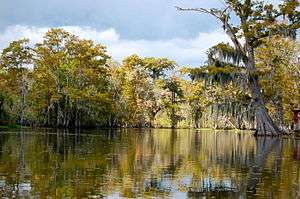Bayou

In usage in the United States, a bayou (/ˈbaɪ.uː/ or /ˈbaɪ.oʊ/,[1][2] from Cajun French) is a body of water typically found in a flat, low-lying area, and can be either an extremely slow-moving stream or river (often with a poorly defined shoreline), or a marshy lake or wetland. The name "bayou" can also refer to a creek whose current reverses daily due to tides and which contains brackish water highly conducive to fish life and plankton. Bayous are commonly found in the Gulf Coast region of the southern United States, notably the Mississippi River Delta, with the states of Louisiana and Texas being famous for them. A bayou is frequently an anabranch or minor braid of a braided channel that is moving much more slowly than the mainstem, often becoming boggy and stagnant. Though fauna varies by region, many bayous are home to crawfish, certain species of shrimp, other shellfish, catfish, frogs, toads, American alligators, American crocodiles, herons, turtles, spoonbills, snakes, leeches and myriad other species.

Etymology
The word was first used by the English in Louisiana and is thought to originate from the Choctaw word "bayuk", which means "small stream".[3] The first settlements of Bayou Teche, and other bayous, were by the Creoles, and that is why bayous are associated with Creole culture.
An alternative spelling, "buyou", has also been used, as in "Pine Buyou", used in a description by Congress in 1833 of Arkansas Territory.
Geography
Bayou Country is most closely associated with Cajun and Creole cultural groups native to the Gulf Coast region generally stretching from Houston, Texas, to Mobile, Alabama, and picking back up in South Florida around the Everglades with its center in New Orleans, Louisiana.
Notable examples
- Bayou Bartholomew
- Bayou Lafourche
- Bayou Teche
- Cypress Bayou
- Bayou St. John
- Big Bayou Canot
- Buffalo Bayou
- Bayou La Batre
See also
- Backswamp
- "Blue Bayou", a 1961 song by Roy Orbison
- "Born on the Bayou", a 1968 song on rock band Creedence Clearwater Revival's second album Bayou Country (1969)
- Billabong
- Florida
- Hurricane on the Bayou
- Houston
- Louisiana
- New Orleans
- Oxbow lake
- Texas
- Yazoo stream
- Bayou Billy is the protagonist of 1989 Nintendo video game The Adventures of Bayou Billy
References
- ↑ "bayou". Dictionary.com Unabridged. Random House. Retrieved 2016-08-20.
- ↑ "bayou". Oxford English Dictionary (3rd ed.). Oxford University Press. September 2005. (Subscription or UK public library membership required.)
- ↑ Online Etymology Dictionary, Dictionnaire de l'Académie française, 9th edition
External links
| Wikimedia Commons has media related to Bayous. |